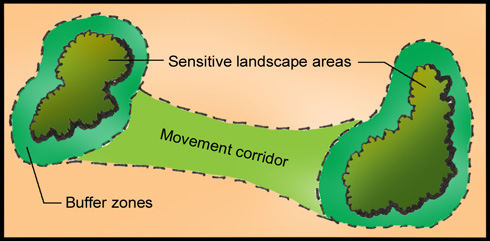GUIDELINES / 2.0 Biodiversity
2.8 Buffers and Corridors

Buffers and corridors are linked together as a conservation strategy. Buffer zones are designated areas used to protect sensitive landscape patches (e.g., wetlands, wildlife reserves) from negative external pressures. Corridors are used to connect the buffered landscape patches.
Buffer zone width should be based on the desired ecological functions, landscape context, and external pressures. Upland buffers of 250 to 1000 feet around wetlands have been recommended for turtles and amphibians. For wildlife reserves or parks, buffer zones may need to be several miles wide.
Refer to 2.10 for distances of edge effects. These distances can serve as a guide for creating buffer zones around habitat patches to protect them from edge effects. See 7.2 for guidance on human activity and buffer zones.
 DOWNLOAD: 2.8 Guidelines and References (PDF)
DOWNLOAD: 2.8 Guidelines and References (PDF)
